Opinion | LNG | LNG Insight | Markets | Natural Gas Prices | NGI All News Access | Regulatory | Shale Daily
Can the Search for a Global LNG Benchmark End With a European or U.S. Natural Gas Contract? – Column
© 2024 Natural Gas Intelligence. All rights reserved.
ISSN © 1532-1231 | ISSN © 2577-9877 | ISSN © 2158-8023 |



